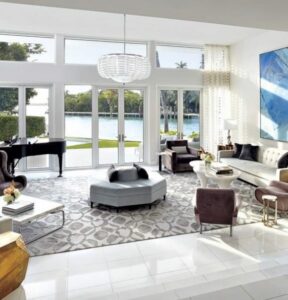 Often times I see clients struggling with finding the correct types of floor coverings for their space. Each home has its own personality and design challenges that can sometimes make us feel stuck. While I’m never an advocate for strict rules that must be followed in design, here is a guide to the dos and don’ts of area rugs and wall to wall carpeting.
Often times I see clients struggling with finding the correct types of floor coverings for their space. Each home has its own personality and design challenges that can sometimes make us feel stuck. While I’m never an advocate for strict rules that must be followed in design, here is a guide to the dos and don’ts of area rugs and wall to wall carpeting.
Don’t be afraid to go custom
“Custom” area rugs can sound daunting and costly. Don’t let the word custom intimidate you! In the long run a properly sized rug will save you lots of headaches; don’t be impatient and get something that isn’t the right size.
You can make a custom rug in several ways and at varying price points. The simplest way is to find a broadloom rug and have it cut and serged or add a binding to the edges that is the perfect size. Broadloom rugs are what we use for wall to wall carpeting. It is made on large rolls about 12’ to 15’ wide, and virtually any length. They simply cut off the amount needed for your area rug and then use a machine to serge the edges, or add a fabric or leather binding to the edges to finish. You can even have them cut on site to do cut outs around a fireplace mantel, or other architectural details that may interfere with a 4 sided rectangle. Palace Oriental Rugs in Wilton is one local vendor I recommend for custom rugs.

Custom rug in production at Palace Oriental Rugs of Wilton
There are also rug manufacturers that can loom a rug to the size of your choice. This takes a longer time because it is produced to order. But can take as little as 2 months in some cases. Typically priced by the square foot, these rugs are a step higher in quality, production and value. Often times you can change colors or scale the design since it is made to order.
You can also have hand-knotted or hand-tufted rugs made to order. These sometimes take up to 6 months to produce and ship to the United States. Made of wool, silk or other materials these rugs can be customized in any way imaginable. Of course with more quality comes a higher price tag. 6 months can seem like a long time to wait, but if it’s a rug you’re going to have for 10 or 20 years, 6 months is just a short blip of time for the perfect product.

Broadloom custom cutting on site around curves and angles (this is actually one of my projects).
Do let your floors “breathe”
When it comes to area rugs, we are trying to add comfort, functionality and visual grounding of a space. We are NOT trying to hide your beautiful floors! If your rug is going to be covering most of the floor space in the room I recommend a healthy 8” margin between the edges of the rug and the wall. Do not push your area rug up against the baseboards.
Don’t go too small!
When it comes to area rugs, bigger is better. Some might think that a smaller rug with more floor space showing will make your room look bigger. The opposite is true. A widespread rug that takes up volume will make your space look bigger.
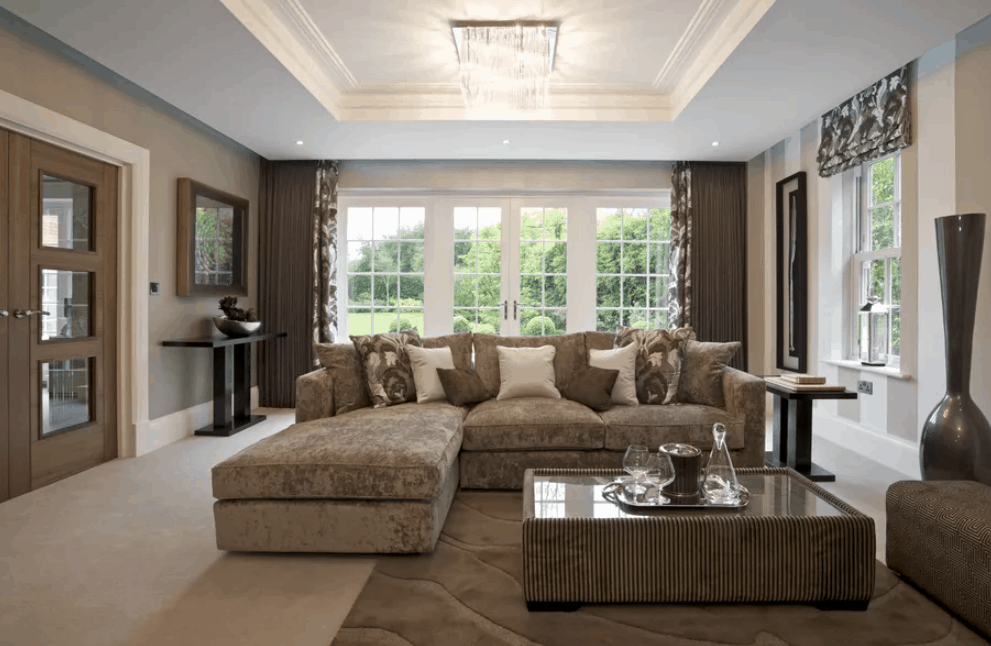
An area rug with furniture half-on, half-off makes the room appear smaller

A more expansive rug under the entire furniture grouping opens up the space.
Do consider your furniture
A side table will wobble if it’s only partially on a rug. Sofas and chairs need to have at least all of the front legs on a rug. A shelving unit with a flat bottom will be safer fully on the floor than with a rug wedged part way underneath. In a bedroom I like to have my area rugs stop just in front of bedside tables and dressers. Take into account the types of furniture you have and where their placement will be on a rug before purchasing. This is another reason why you shouldn’t be afraid to get a custom fit, or have a store bought area rug cut down.
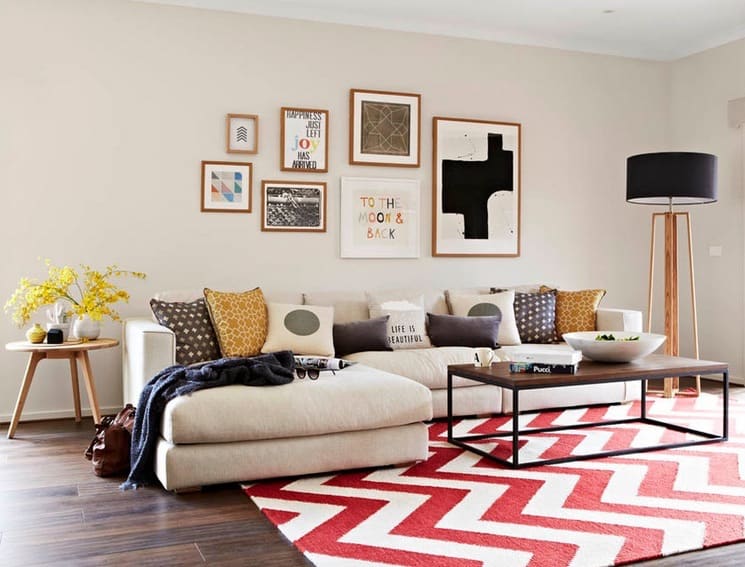
A rug that is not wide enough for the entire sectional instantly dwarfs the size of the rug and the room.
Don’t create a tripping hazard
Beware of corners sticking out into the entrance of a doorway or splitting a walkway in half with the edges of your area rug. My best recommendation for this is to take 2 tape measures and lay them out, one at the length and one at the width. Mark all 4 corners of the rug with painters tape onto the floor. Spend a few days and notice if you would be constantly tripping on a corner, and modify the size of the rug accordingly before purchasing.
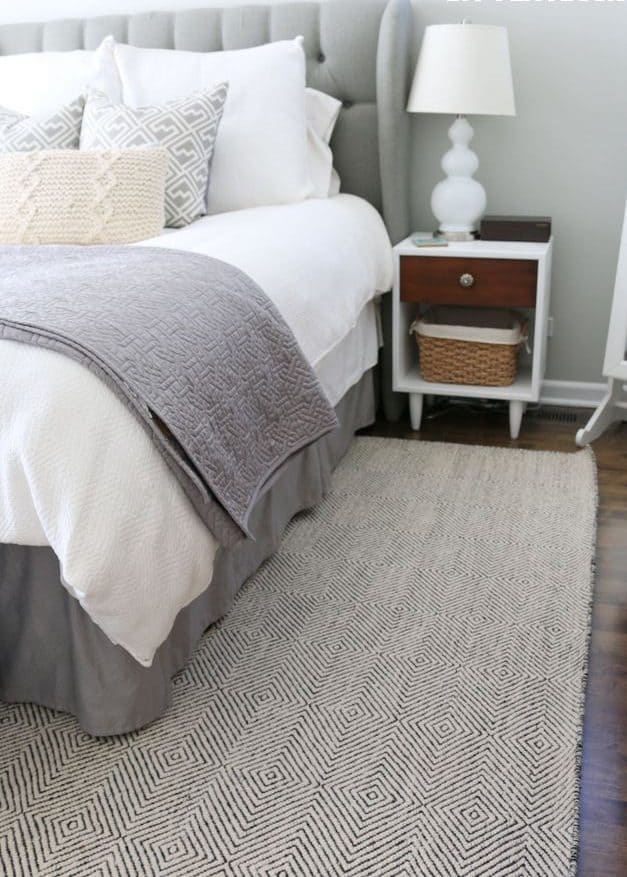
This rug is wide enough to make a safe walkway to the side of the bed, so that you wouldn’t be walking on it half-on, half-off.
Do consider content and location
Make sure you select a rug or carpet that is appropriate for the space it will be in. Don’t be afraid to spend more on silk or viscose in a grand foyer, or in bedrooms where people won’t be eating. However, avoid silk or viscose on a stair runner that is high traffic all over. I recommend wool or nylon for high traffic areas. Wool is a highly cleanable natural material. Nylon is synthetic but durable. Some broadloom carpet manufacturers now have synthetic nylon that has a softness and sheen similar to a silk or viscose blend. Viscose is easily stained when it gets wet — I highly recommend thinking twice before using in a dining room or in runners and hallways. If you’re worried about young kids or pets destroying rugs consider “power loomed” area rugs. They are machine made and at a fraction of the price of hand woven rugs. They are great for kids’ bedrooms or playrooms, where you will likely need to replace it within a few years.
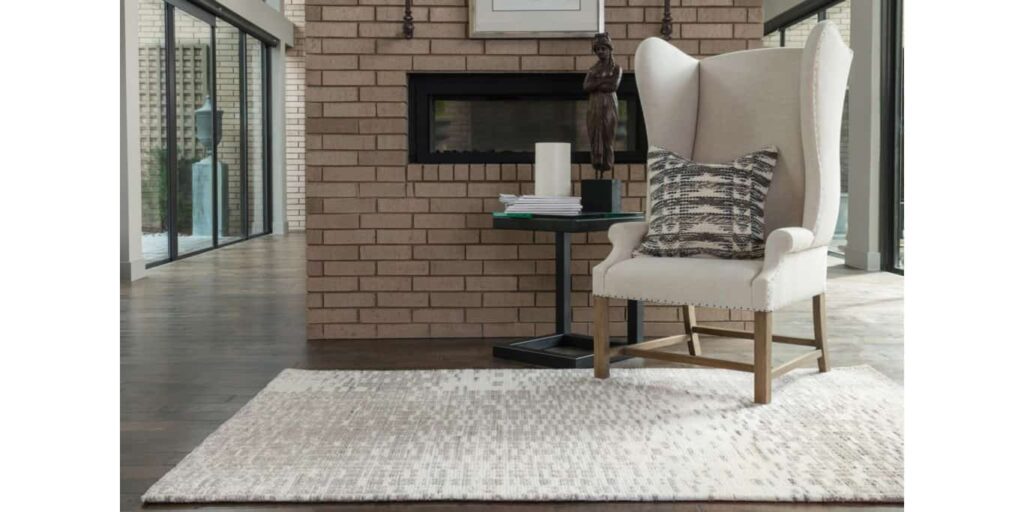
Power loomed rugs like this one from Loloi are great for a kids bedroom or a casual family room for a young growing family that isn’t ready to invest in a rug because it will get damaged.
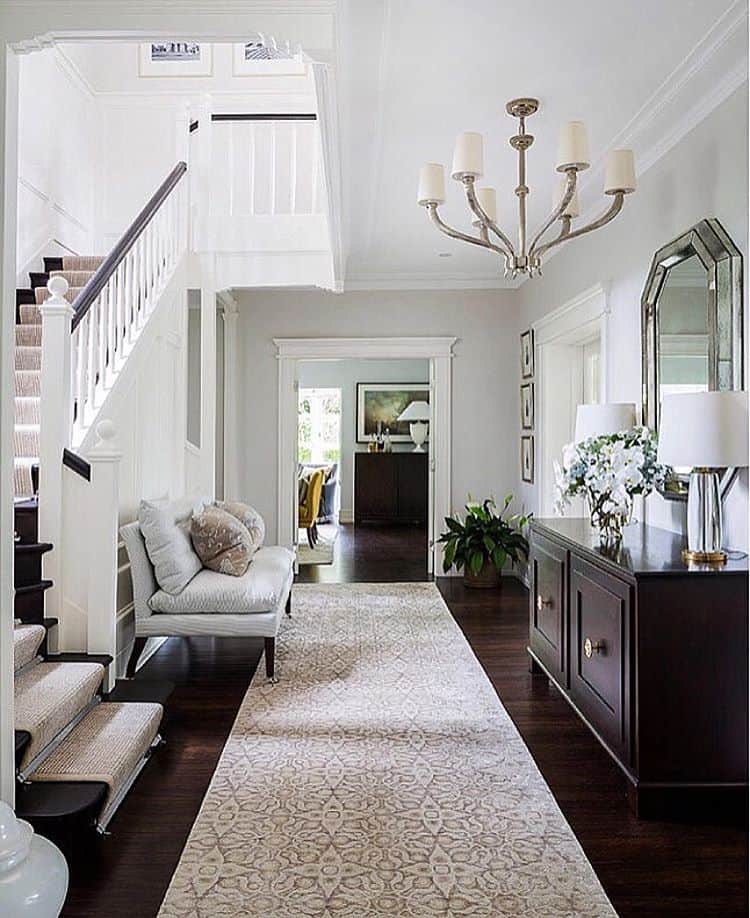
A formal entry rug that doesn’t match, but coordinates nicely with the stair runner.
Don’t hide your beautiful floors
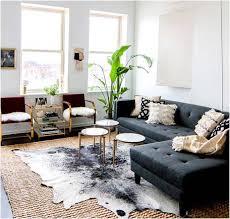
Example of layering rugs with a hide over a sisal.
These days you will get more value for your home with more hardwood flooring. That means wall to wall carpeting in the main floor living spaces is a no go. Invest in redoing your floors, and add an area rug on top to help ground a conversational seating group. However, in the upstairs bedrooms don’t be afraid to use wall to wall carpeting. In nurseries or kids bedrooms you might be more comfortable having the largest soft surface area as possible for small children to crawl or play on. But again, consider the fiber content for durability! You could even consider getting a neutral wall to wall carpet and laying a fun bold area rug on top for a pop of color and to help ground a furniture arrangement.
Don’t be afraid of the “dark side”
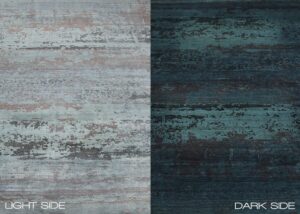 Most people don’t realize that rugs that have a sheen will have a light side and a dark side. Fibers such as silk, viscose or a poly blend have a little shine due to the nature of the construction; light will reflect off it differently from opposite angles. The colors will appear more vibrant and contrasting when laid in one direction, while darker and more muted from the other. Turn the rug or stand on different sides to decide which you like best. Then make sure to orient the rug so that the side you prefer is facing the direction the room will most often be viewed or entered from. This quality is NOT a defect in the rug, it is due to the material.
Most people don’t realize that rugs that have a sheen will have a light side and a dark side. Fibers such as silk, viscose or a poly blend have a little shine due to the nature of the construction; light will reflect off it differently from opposite angles. The colors will appear more vibrant and contrasting when laid in one direction, while darker and more muted from the other. Turn the rug or stand on different sides to decide which you like best. Then make sure to orient the rug so that the side you prefer is facing the direction the room will most often be viewed or entered from. This quality is NOT a defect in the rug, it is due to the material.
Do consider the pile
When installing wall to wall carpeting do you want a loop or cut pile? Cut pile means the fibers are standing up vertically. Over time in high traffic areas the fiber will not hold up as well to crushing from foot traffic. However, a loop style construction could get destroyed a clawing cats or other pets. And will be less soft for crawling babies, or kids playing around on the floor. I like to use a mixed construction of some loop and some cut pile – a “high low” rug. This adds a dynamic and more texture and can often times help conceal dirty and stains in the long run.
[one_half]
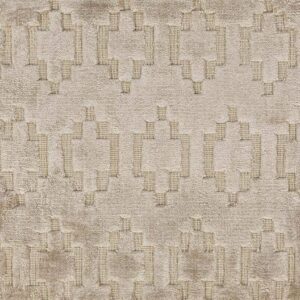
Detail of high low rug – adds dimension
[/one_half][one_half_last]
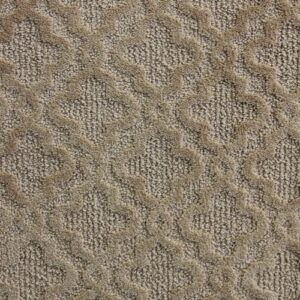
The background of this carpet is a loop construction and the trellis pattern is cut, creating a softer, plusher pile.
[/one_half_last]
Don’t be afraid to try it out!

Poms are the rug equivalent of paint samples
Installing wall to wall carpeting or buying an area rug is an INVESTMENT. Ask your designer for samples. Especially if you’re buying sight unseen. Many manufacturers have 18” corner samples, or you can purchase a small 2’x3′ mat to ensure that the colors, sheen texture and pattern are what you like and work with your other décor elements. Most carpet showrooms can order small samples or will let you borrow a carpet board with a large sample of the pattern and swatches of all the colors. When investing in a hand made rug, if it is in stock at the carpet store ask to take a few different options on loan to try them out. Keep your favorite one overnight. Look at your samples in the light at all times of day and make sure you are in love before buying!
Don’t be afraid of patterns
Some people may be wary of patterned rugs, fearing they will tire of it over time. This is why it’s important to bring samples into the space and not rush into making a decision. Patterns can be very beneficial. A small scale pattern on a runner can add interest as well as hide stains. A large bold pattern can tie an expansive room together. In an all white or neutral room you can make your rug a beautiful piece of contemporary art on the floor. Imagine a rug like a piece of art you fall in love with all over again every time you see it.
[one_half]

A subtle medium scale pattern adds interest to this runner without being over bearing.
[/one_half][one_half_last]

The bold patterns of this wood floor work nicely with the subtle texture driven motif of this runner.
[/one_half_last]

The bold patterns of this rug work perfectly the with natural solids of this gorgeous room. It acts as a piece of art on the floor.
Remember, your home’s décor is what you make of it! Don’t feel pressured to follow rules or trends. Your home is a reflection of you. So do what YOU love and what is special to you. Rugs and carpeting are investments in your home, don’t feel rushed to make your decision. Don’t settle for reactions like “it’s fine” or “its not that bad”; make sure you say “I love it!” before you buy.
[divider style=”single” border=”small”]

Katie Canfield is the founder and principal designer at Studio KC. Studio KC got its humble start in 2015 when Katie was just 23 years old. While she was freelancing with other interior designers in the NY and CT area she also became a go-to designer for local contractors and trades that needed a designer’s help for their clients whether it be for custom cabinetry drawings or plans for a gut renovation on an entire home.
Katie Canfield’s design aesthetic is eclectic and flexible. She delights in the marriage between old and new- keeping spaces approachable but still matching each client’s unique aesthetic and family narrative. Her passion for design keeps her motivated and constantly on the hunt for new trends and materials. Her broad experience includes an art history background, study at the Accademia Italiana in Florence, a stint with the renowned Manhattan firm Amanda Nisbet Design, as well as collaborations with builders and designers across the tri-state area. She’s seen it all: from gutting prewar Manhattan apartments to new construction in the ‘burbs.





